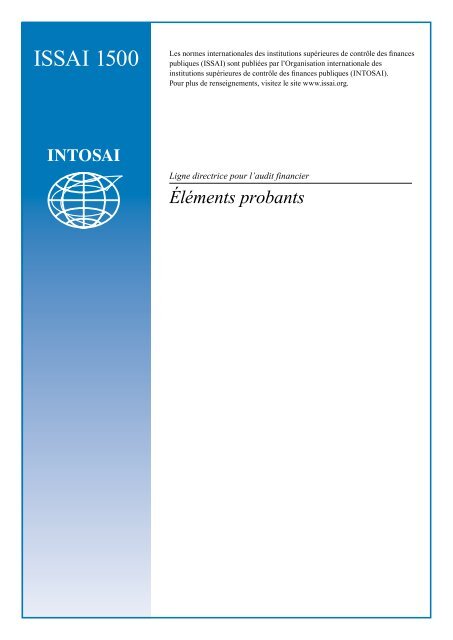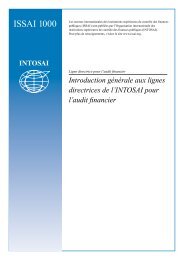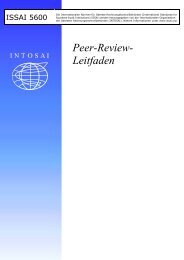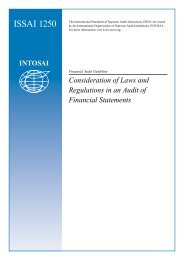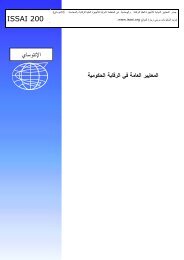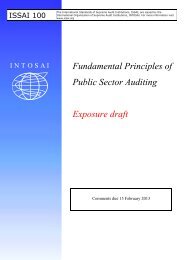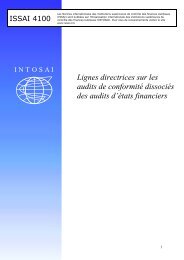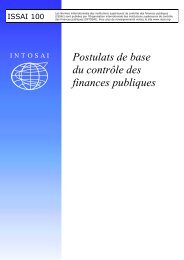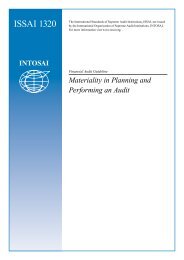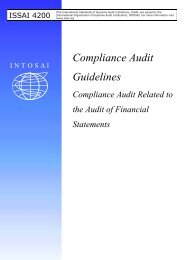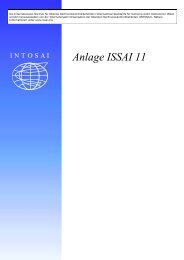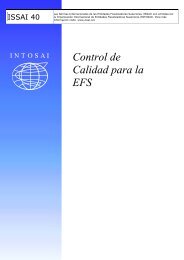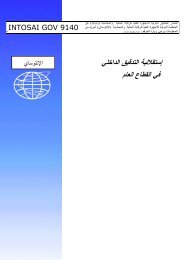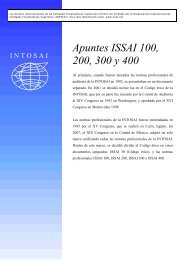You also want an ePaper? Increase the reach of your titles
YUMPU automatically turns print PDFs into web optimized ePapers that Google loves.
<strong>ISSAI</strong> <strong>1500</strong><br />
Les normes internationales des institutions supérieures de contrôle des finances<br />
publiques (<strong>ISSAI</strong>) sont publiées par l’Organisation internationale des<br />
institutions supérieures de contrôle des finances publiques (INTOSAI).<br />
Pour plus de renseignements, visitez le site www.issai.org.<br />
Ligne directrice pour l’audit financier<br />
Éléments probants
<strong>ISSAI</strong> <strong>1500</strong><br />
COMMISSION DES NORMES PROFESSIONNELLES DE L’INTOSAI<br />
SOUS-COMMISSION DES NORMES DE CONTROLE DE<br />
L’AUDIT FINANCIER - SECRETARIAT<br />
Riksrevisionen • 114 90 Stockholm • Suède<br />
Tél. +46 5171 4000 • Fax +46 5171 4111 • Courriel: projectsecretariat@riksrevisionen.se<br />
Secrétariat général de l’INTOSAI - RECHNUNGSHOF<br />
(institution supérieure de contrôle de l’Autriche)<br />
DAMPFSCHIFFSTRASSE 2<br />
1033 VIENNE<br />
AUTRICHE<br />
Tél. +43 (1) 711 71<br />
Fax +43 (1) 718 09 69<br />
intosai@rechnungshof.gv.at<br />
http://www.intosai.org<br />
La présente ligne directrice pour l’audit financier s’inspire de la norme internationale d’audit [International<br />
Standard on Auditing] (ISA) 500 «Éléments probants», établie par le Conseil des normes internationales<br />
d’audit et d’assurance [International Auditing and Assurance Standards Board] (IAASB) et publiée par la<br />
Fédération internationale des experts-comptables [International Federation of Accountants] (IFAC). La norme<br />
ISA est reprise dans la présente ligne directrice avec l’autorisation de l’IFAC.<br />
566<br />
Éléments probants
<strong>ISSAI</strong> <strong>1500</strong><br />
Table des matières de la norme <strong>ISSAI</strong> <strong>1500</strong><br />
NOTE SUR L’UTILISATION DE LA NORME ISA 500<br />
Paragraphe<br />
Contexte<br />
Introduction à la norme ISA<br />
Contenu de la note................................................................................................................................ P1<br />
Applicabilité de la norme ISA à l’audit dans le secteur public...........................................................P2<br />
Indications supplémentaires sur les questions relatives au secteur public<br />
Caractère suffisant et approprié des éléments probants............................................................... P3–P10<br />
Annexe: sources des éléments probants concernant la gestion des risques liés aux<br />
dispositions législatives et réglementaires<br />
NORME INTERNATIONALE D’AUDIT 500<br />
Introduction<br />
Champ d’application de la présente norme ISA..................................................................................1–2<br />
Date d’entrée en vigueur......................................................................................................................... 3<br />
Objectif....................................................................................................................................................... 4<br />
Définitions.................................................................................................................................................. 5<br />
Diligences requises<br />
Caractère suffisant et approprié des éléments probants......................................................................... 6<br />
Informations à utiliser comme éléments probants............................................................................. 7–9<br />
Sélection d’éléments à des fins de tests en vue de recueillir des éléments probants............................10<br />
Incohérence entre les éléments probants ou doute sur leur fiabilité.....................................................11<br />
Modalités d’application et autres informations explicatives<br />
Caractère suffisant et approprié des éléments probants...............................................................A1-A25<br />
Informations à utiliser comme éléments probants................................................................... A26–A51<br />
Sélection d’éléments à des fins de tests en vue de recueillir des éléments probants................A52–A56<br />
Éléments probants<br />
567
<strong>ISSAI</strong> <strong>1500</strong><br />
Note de pratique 500<br />
568 Éléments probants
<strong>ISSAI</strong> <strong>1500</strong><br />
Note de pratique 500<br />
Note 1 sur l’utilisation de la norme internationale d’audit (ISA) 500<br />
Éléments probants<br />
Contexte<br />
La présente note fournit des indications supplémentaires sur la norme internationale d’audit<br />
[International Standard on Auditing] (ISA) 500 relative aux éléments probants. Elle doit être lue<br />
conjointement avec la norme ISA. La norme ISA 500 est applicable aux audits d’états financiers pour les<br />
périodes commençant le 15 décembre 2009 ou après. La présente note prend effet à la même date que la<br />
norme ISA.<br />
Introduction à la norme ISA<br />
La norme ISA 500 explique ce que l’on entend par éléments probants dans le cadre d’un audit d’états<br />
financiers, et traite des obligations de l’auditeur concernant la conception et la mise en úuvre de<br />
procédures d’audit en vue de recueillir des éléments probants suffisants et appropriés pour tirer des<br />
conclusions raisonnables sur lesquelles fonder l’opinion d’audit.<br />
La norme ISA 500 est applicable à tous les éléments probants collectés au cours de l’audit. D’autres<br />
normes ISA portent sur les aspects spécifiques de l’audit (par exemple la norme ISA 315 2 ), sur les<br />
éléments probants à recueillir en relation avec des sujets particuliers (par exemple la norme ISA 570 3 ),<br />
sur les procédures spécifiques pour collecter des éléments probants (par exemple la norme ISA 520 4 ), et<br />
sur l’appréciation visant à déterminer si des éléments probants suffisants et appropriés ont été collectés<br />
(par exemple la norme ISA 200 5 et la norme ISA 330 6 ).<br />
Contenu de la note<br />
P1. La présente note fournit des indications supplémentaires aux auditeurs du secteur public en ce qui<br />
concerne:<br />
a) le caractère suffisant et approprié des éléments probants.<br />
Applicabilité de la norme ISA à l’audit dans le secteur public<br />
P2. La norme ISA 500 s’applique aux auditeurs des entités du secteur public en leur qualité<br />
d’auditeurs des états financiers.<br />
1 Toutes les notes doivent être lues parallèlement à la norme <strong>ISSAI</strong> 1000, «Introduction générale aux lignes directrices de l’INTOSAI pour l’audit financier».<br />
2 Norme ISA 315, «Identification et évaluation des risques d’anomalies significatives par la connaissance de l’entité et de son environnement».<br />
3 Norme ISA 570, «Continuité de l’exploitation».<br />
4 Norme ISA 520, «Procédures analytiques».<br />
5 Norme ISA 200, «Objectifs généraux de l’auditeur indépendant et conduite d’un audit selon les normes internationales d’audit».<br />
6 Norme ISA 330, «Réponses de l’auditeur aux risques évalués».<br />
Éléments probants<br />
569
<strong>ISSAI</strong> <strong>1500</strong><br />
Note de pratique 500<br />
Indications supplémentaires sur les questions relatives au secteur<br />
public<br />
Caractère suffisant et approprié des éléments probants<br />
P3. Comme cela est indiqué au paragraphe A7 de la norme ISA 500, certains éléments probants sont<br />
collectés par la mise en úuvre de procédures d’audit réalisées en vue de tester les documents<br />
comptables. Les éléments probants comprennent à la fois les informations qui justifient et<br />
corroborent les assertions de la direction, et toutes celles qui les contredisent. S’agissant des états<br />
financiers dans le secteur public, la direction peut souvent déclarer que les transactions et les<br />
événements se sont déroulés conformément à la législation ou au texte législatif et réglementaire<br />
applicable. Ces assertions peuvent être comprises dans l’étendue d’un audit financier 7 . En<br />
l’occurrence, les auditeurs du secteur public peuvent se référer à la norme <strong>ISSAI</strong> 4200 8 .<br />
P4. Lorsqu’ils examinent des informations de sources indépendantes de l’entité, comme cela<br />
est indiqué au paragraphe A9 de la norme ISA 500, les auditeurs du secteur public peuvent<br />
considérer que ces sources sont indépendantes de l’entité même si, en définitive, elles relèvent de<br />
la même autorité, par exemple dans le cas d’agences gouvernementales indépendantes sur le plan<br />
opérationnel mais relevant d’une seule autorité. Dans le secteur public, les données de référence<br />
peuvent provenir d’autres sources, par exemple des comparaisons entre des programmes<br />
similaires ou des indicateurs de performance.<br />
P5. Lorsqu’ils examinent les sources des éléments probants conformément au paragraphe A2 de la<br />
norme ISA 500, les auditeurs du secteur public peuvent aussi tenir compte des éléments probants<br />
acquis lors d’audits de la performance ou d’autres travaux d’audit relatifs à l’entité.<br />
P6. Comme cela est expliqué au paragraphe A11 de la norme ISA 500, les éléments probants<br />
collectés lors d’audits précédents peuvent, dans certaines circonstances, fournir des éléments<br />
probants appropriés lorsque l’auditeur a appliqué des procédures d’audit pour vérifier qu’ils sont<br />
toujours pertinents. Lorsqu’ils se fondent sur des éléments probants obtenus lors d’audits de la<br />
performance précédents, les auditeurs du secteur public déterminent si les assertions utilisées et<br />
les tests effectués sont appropriés aux fins de l’audit des états financiers.<br />
P7. Si le mandat d’audit fixe des objectifs en matière de régularité des transactions, les auditeurs<br />
du secteur public devront peut-être tenir compte de la nature et du calendrier des procédures<br />
d’audit, comme cela est expliqué au paragraphe A12 de la norme ISA 500. À titre d’exemple,<br />
l’écoulement du temps peut avoir une incidence négative sur les possibilités de mettre en œuvre<br />
certaines procédures d’audit visant à déterminer la régularité de la transaction ou l’efficacité des<br />
contrôles.<br />
7 Dans le contexte des indications supplémentaires fournies par les notes sur l’utilisation des normes ISA, le terme «audit financier» désigne les audits díétats financiers,<br />
ainsi que les audits portant sur les assertions supplémentaires relatives à la régularité et à la conformité lorsquíelles sont associées à un audit díétats financiers (audit<br />
financier/de la régularité). Les normes ISA portent sur les audits díétats financiers.<br />
8 Norme <strong>ISSAI</strong> 4200, «Lignes directrices [de l’INTOSAI] sur les audits de conformité associés à un audit d’états financiers».<br />
570 Éléments probants
<strong>ISSAI</strong> <strong>1500</strong><br />
Note de pratique 500<br />
P8. Les entités du secteur public auront généralement mis en place des contrôles internes conçus<br />
pour garantir la régularité des transactions. Cependant, lorsque l’entité auditée est responsable de<br />
l’octroi, à des tiers, de subventions ou d’autres aides financières, la régularité de la transaction<br />
dépendra souvent du respect, par ces tiers, des critères et des conditions d’éligibilité à l’aide en<br />
question. Il conviendra alors peut-être de collecter des éléments probants attestant que l’entité<br />
a rempli ses obligations en matière de vérification des transactions de ces tiers (comme cela est<br />
indiqué à l’annexe 1 de la présente note).<br />
P9. Lorsqu’ils examinent les indications figurant au paragraphe A13 de la norme ISA 500, les<br />
auditeurs du secteur public tiennent compte du fait que les diligences requises en matière de<br />
conservation des données pour les entités du secteur public peuvent différer en fonction de<br />
la législation applicable. Les auditeurs du secteur public se familiarisent avec la législation<br />
applicable à la conservation des données.<br />
P10. Les auditeurs du secteur public travaillant dans certains environnements, comme une ISC<br />
exerçant une fonction juridictionnelle (Cour des comptes), sont parfois tenus de respecter des<br />
dispositions législatives et réglementaires qui exigent d’eux qu’ils comprennent et suivent des<br />
procédures précises liées aux règles de preuve. Les auditeurs du secteur public se familiarisent<br />
avec les politiques et les procédures qui décrivent les diligences supplémentaires requises en<br />
ce qui concerne les éléments probants et prévues pour garantir la conformité aux règles de<br />
preuve applicables. À titre d’exemple, les auditeurs du secteur public travaillant dans ce type<br />
d’environnement peuvent être tenus de prendre en considération les questions suivantes liées à la<br />
collecte d’éléments probants:<br />
• la législation imposant des diligences supplémentaires en matière d’éléments probants,<br />
• l’étendue de ces diligences supplémentaires (c’est-à-dire savoir si elles doivent s’appliquer<br />
à tous les documents relatifs à la mission d’audit ou à des documents spécifiques relatifs à<br />
certaines questions d’audit),<br />
• le traitement, les formalités ou les diligences supplémentaires dont pourraient faire l’objet les<br />
éléments probants,<br />
• la finalité de chaque diligence supplémentaire lorsqu’il s’agit de garantir une procédure<br />
régulière tout au long des étapes de l’audit,<br />
• toute restriction susceptible d’être imposée en matière d’éléments probants en raison de la<br />
manière particulière avec laquelle ils ont été collectés et/ou produits.<br />
Éléments probants<br />
571
<strong>ISSAI</strong> <strong>1500</strong><br />
Note de pratique 500<br />
Annexe: sources des éléments probants concernant la gestion des<br />
risques liés aux dispositions législatives et réglementaires<br />
Risque Description Sources éventuelles d’éléments probants<br />
Complexité des<br />
règlements<br />
Le risque díerreur est díautant<br />
plus élevé que les règlements sont<br />
complexes, par exemple à cause díune<br />
mauvaise compréhension ou díune<br />
interprétation erronée d’un règlement,<br />
ou encore díune erreur lors de son<br />
application.<br />
• Des procédures formelles et documentées<br />
pour la transposition de dispositions<br />
législatives en instructions pratiques,<br />
• des plans de contrôle structurés et<br />
documentés permettant de suivre les<br />
activités de chaque gestionnaire de<br />
programme,<br />
Nouvelle<br />
législation<br />
Programmes<br />
internationaux<br />
(financés par<br />
les Nations<br />
unies, par líUE<br />
ou par díautres<br />
institutions)<br />
Une nouvelle législation peut nécessiter<br />
líintroduction de nouvelles procédures<br />
administratives et de contrôle, ce qui<br />
peut donner lieu à des erreurs affectant<br />
la conception ou la mise en úuvre<br />
des contrôles requis pour garantir la<br />
régularité.<br />
Lorsquíelles sont élaborées par ces<br />
institutions, les règles et les orientations<br />
risquent díêtre mal interprétées ou<br />
omises dans les instructions internes.<br />
• des rapports d’examen élaborés à<br />
l’occasion d’un audit interne ou d’un<br />
autre audit indépendant des plans de<br />
contrôle des programmes et des manuels<br />
de procédures.<br />
• Des procédures formelles et documentées<br />
pour la transposition de dispositions<br />
législatives en règles applicables à<br />
un programme. Des plans de contrôle<br />
structurés et l’examen indépendant des<br />
instructions pratiques et des plans de<br />
contrôle peuvent également constituer<br />
des éléments probants lorsque des<br />
programmes sont mis en úuvre à la suite<br />
d’une nouvelle législation.<br />
• Les sources d’éléments probants<br />
mentionnées dans la partie sur la<br />
complexité des règlements peuvent<br />
également être valables pour les<br />
programmes financés.<br />
572 Éléments probants
<strong>ISSAI</strong> <strong>1500</strong><br />
Note de pratique 500<br />
Risque Description Sources éventuelles d’éléments probants<br />
Services et<br />
programmes<br />
exécutés par<br />
des tiers.<br />
Lorsque les programmes sont<br />
gérés par des mandataires, les<br />
services de líentité en perdent,<br />
en partie, le contrôle direct et<br />
doivent parfois compter sur<br />
ces mandataires pour assurer la<br />
conformité aux textes législatifs<br />
et réglementaires.<br />
• Des accords en bonne et due forme entre líentité<br />
et le mandataire, où sont définies les procédures<br />
de contrôle à appliquer pour la gestion des<br />
services,<br />
• des procédures documentées et les résultats du<br />
contrôle de gestion et du suivi des activités des<br />
tiers,<br />
• les rapports relatifs aux inspections effectuées<br />
auprès de tiers par l’audit interne pour examiner<br />
les systèmes et les procédures, y compris ceux<br />
qui concernent la régularité,<br />
Paiements et<br />
encaissements<br />
effectués sur<br />
la base de<br />
demandes ou<br />
de déclarations<br />
La capacité díune entité à<br />
confirmer le respect des textes<br />
législatifs et réglementaires peut<br />
être limitée, par exemple quand<br />
les critères fixés pour bénéficier<br />
díune subvention ne font pas<br />
líobjet díun contrôle direct.<br />
• un rapport exprimant une assurance ou un<br />
rapport sur des procédures convenues en<br />
matière de paiements et d’encaissements, ou<br />
sur les contrôles relatifs aux paiements et aux<br />
encaissements, effectués par l’auditeur de la<br />
tierce partie.<br />
• Des instructions et des indications du service à<br />
l’intention des demandeurs précisant clairement<br />
les critères à remplir pour pouvoir introduire des<br />
demandes,<br />
• l’existence de conditions types en matière de<br />
fourniture de pièces justificatives du droit à la<br />
subvention, afin díétayer les demandes (il peut<br />
síagir d’une condition préalable au paiement de<br />
la subvention ou d’une condition à remplir après<br />
la fin de líactivité subventionnée),<br />
• des rapports élaborés à la suite d’un contrôle des<br />
documents, etc., effectué auprès des demandeurs<br />
pour en confirmer l’éligibilité,<br />
• des procédures documentées visant à évaluer<br />
la situation financière des demandeurs avant de<br />
leur octroyer une subvention, ainsi qu’à contrôler<br />
s’ils restent solvables,<br />
• la certification indépendante, par un auditeur<br />
externe, de la demande de subvention.<br />
Éléments probants<br />
573
<strong>ISSAI</strong> <strong>1500</strong><br />
Note de pratique 500<br />
574 Éléments probants
International<br />
Auditing and<br />
Assurance<br />
Standards<br />
Board<br />
ISA 500<br />
April 2009<br />
International Standard on Auditing<br />
Audit Evidence
<strong>ISSAI</strong> <strong>1500</strong><br />
ISA 500<br />
International Auditing and Assurance Standards Board<br />
International Federation of Accountants<br />
545 Fifth Avenue, 14 th Floor<br />
New York, New York 10017 USA<br />
This International Standard on Auditing (ISA) 500, “Audit Evidence” was prepared by<br />
the International Auditing and Assurance Standards Board (IAASB), an independent<br />
standard-setting body within the International Federation of Accountants (IFAC). The<br />
objective of the IAASB is to serve the public interest by setting high quality auditing<br />
and assurance standards and by facilitating the convergence of international and national<br />
standards, thereby enhancing the quality and uniformity of practice throughout the<br />
world and strengthening public confidence in the global auditing and assurance<br />
profession.<br />
This publication may be downloaded free of charge from the IFAC website:<br />
http://www.ifac.org. The approved text is published in the English language.<br />
The mission of IFAC is to serve the public interest, strengthen the worldwide<br />
accountancy profession and contribute to the development of strong international<br />
economies by establishing and promoting adherence to high quality professional<br />
standards, furthering the international convergence of such standards and speaking out<br />
on public interest issues where the profession’s expertise is most relevant.<br />
Copyright © April 2009 by the International Federation of Accountants (IFAC). All<br />
rights reserved. Permission is granted to make copies of this work provided that such<br />
copies are for use in academic classrooms or for personal use and are not sold or<br />
disseminated and provided that each copy bears the following credit line: “Copyright ©<br />
April 2009 by the International Federation of Accountants (IFAC). All rights reserved.<br />
Used with permission of IFAC. Contact permissions@ifac.org for permission to<br />
reproduce, store or transmit this document.” Otherwise, written permission from IFAC<br />
is required to reproduce, store or transmit, or to make other similar uses of, this<br />
document, except as permitted by law. Contact permissions@ifac.org.<br />
ISBN: 978-1-60815-011-3<br />
1<br />
576 Éléments probants
<strong>ISSAI</strong> <strong>1500</strong><br />
ISA 500<br />
Introduction<br />
INTERNATIONAL STANDARD ON AUDITING 500<br />
AUDIT EVIDENCE<br />
(Effective for audits of financial statements for periods<br />
beginning on or after December 15, 2009)<br />
CONTENTS<br />
Paragraph<br />
Scope of this ISA ........................................................................................ 1-2<br />
Effective Date ............................................................................................. 3<br />
Objective .................................................................................................... 4<br />
Definitions .................................................................................................. 5<br />
Requirements<br />
Sufficient Appropriate Audit Evidence ....................................................... 6<br />
Information to Be Used as Audit Evidence ................................................. 7-9<br />
Selecting Items for Testing to Obtain Audit Evidence ................................ 10<br />
Inconsistency in, or Doubts over Reliability of, Audit Evidence ................ 11<br />
Application and Other Explanatory Material<br />
Sufficient Appropriate Audit Evidence .......................................................<br />
A1-A25<br />
Information to Be Used as Audit Evidence ................................................. A26-A51<br />
Selecting Items for Testing to Obtain Audit Evidence ................................ A52-A56<br />
Inconsistency in, or Doubts over Reliability of, Audit Evidence ................<br />
A57<br />
International Standard on Auditing (ISA) 500, “Audit Evidence” should be read in<br />
conjunction with ISA 200, “Overall Objectives of the Independent Auditor and the<br />
Conduct of an Audit in Accordance with International Standards on Auditing.”<br />
2<br />
Éléments probants<br />
577
<strong>ISSAI</strong> <strong>1500</strong><br />
ISA 500<br />
AUDIT EVIDENCE<br />
Introduction<br />
Scope of this ISA<br />
1. This International Standard on Auditing (ISA) explains what constitutes audit<br />
evidence in an audit of financial statements, and deals with the auditor’s<br />
responsibility to design and perform audit procedures to obtain sufficient<br />
appropriate audit evidence to be able to draw reasonable conclusions on which<br />
to base the auditor’s opinion.<br />
2. This ISA is applicable to all the audit evidence obtained during the course of<br />
the audit. Other ISAs deal with specific aspects of the audit (for example, ISA<br />
315 1 ), the audit evidence to be obtained in relation to a particular topic (for<br />
example, ISA 570 2 ), specific procedures to obtain audit evidence (for example,<br />
ISA 520 3 ), and the evaluation of whether sufficient appropriate audit evidence<br />
has been obtained (ISA 200 4 and ISA 330 5 ).<br />
Effective Date<br />
3. This ISA is effective for audits of financial statements for periods beginning on<br />
or after December 15, 2009.<br />
Objective<br />
4. The objective of the auditor is to design and perform audit procedures in such a<br />
way as to enable the auditor to obtain sufficient appropriate audit evidence to<br />
be able to draw reasonable conclusions on which to base the auditor’s opinion.<br />
Definitions<br />
5. For purposes of the ISAs, the following terms have the meanings attributed<br />
below:<br />
(a)<br />
Accounting records – The records of initial accounting entries and<br />
supporting records, such as checks and records of electronic fund<br />
transfers; invoices; contracts; the general and subsidiary ledgers, journal<br />
entries and other adjustments to the financial statements that are not<br />
reflected in journal entries; and records such as work sheets and<br />
spreadsheets supporting cost allocations, computations, reconciliations<br />
and disclosures.<br />
1<br />
2<br />
3<br />
4<br />
5<br />
ISA 315, “Identifying and Assessing the Risks of Material Misstatement through Understanding the<br />
Entity and Its Environment.”<br />
ISA 570, “Going Concern.”<br />
ISA 520, “Analytical Procedures.”<br />
ISA 200, “Overall Objectives of the Independent Auditor and the Conduct of an Audit in Accordance<br />
with International Standards on Auditing.”<br />
ISA 330, “The Auditor’s Responses to Assessed Risks. ”<br />
3<br />
578 Éléments probants
<strong>ISSAI</strong> <strong>1500</strong><br />
ISA 500<br />
AUDIT EVIDENCE<br />
(b)<br />
(c)<br />
(d)<br />
(e)<br />
Requirements<br />
Appropriateness (of audit evidence) – The measure of the quality of<br />
audit evidence; that is, its relevance and its reliability in providing<br />
support for the conclusions on which the auditor’s opinion is based.<br />
Audit evidence – Information used by the auditor in arriving at the<br />
conclusions on which the auditor’s opinion is based. Audit evidence<br />
includes both information contained in the accounting records<br />
underlying the financial statements and other information.<br />
Management’s expert – An individual or organization possessing<br />
expertise in a field other than accounting or auditing, whose work in<br />
that field is used by the entity to assist the entity in preparing the<br />
financial statements.<br />
Sufficiency (of audit evidence) – The measure of the quantity of audit<br />
evidence. The quantity of the audit evidence needed is affected by the<br />
auditor’s assessment of the risks of material misstatement and also by<br />
the quality of such audit evidence.<br />
Sufficient Appropriate Audit Evidence<br />
6. The auditor shall design and perform audit procedures that are appropriate in<br />
the circumstances for the purpose of obtaining sufficient appropriate audit<br />
evidence. (Ref: Para. A1-A25)<br />
Information to Be Used as Audit Evidence<br />
7. When designing and performing audit procedures, the auditor shall consider the<br />
relevance and reliability of the information to be used as audit evidence. (Ref:<br />
Para. A26-A33)<br />
8. If information to be used as audit evidence has been prepared using the work of<br />
a management’s expert, the auditor shall, to the extent necessary, having regard<br />
to the significance of that expert’s work for the auditor’s purposes: (Ref: Para.<br />
A34-A36)<br />
(a)<br />
(b)<br />
(c)<br />
Evaluate the competence, capabilities and objectivity of that expert;<br />
(Ref: Para. A37-A43)<br />
Obtain an understanding of the work of that expert; and (Ref: Para.<br />
A44-A47)<br />
Evaluate the appropriateness of that expert’s work as audit evidence for<br />
the relevant assertion. (Ref: Para. A48)<br />
9. When using information produced by the entity, the auditor shall evaluate<br />
whether the information is sufficiently reliable for the auditor’s purposes,<br />
including as necessary in the circumstances:<br />
4<br />
Éléments probants<br />
579
<strong>ISSAI</strong> <strong>1500</strong><br />
ISA 500<br />
AUDIT EVIDENCE<br />
(a)<br />
(b)<br />
Obtaining audit evidence about the accuracy and completeness of the<br />
information; and (Ref: Para. A49-A50)<br />
Evaluating whether the information is sufficiently precise and detailed<br />
for the auditor’s purposes. (Ref: Para. A51)<br />
Selecting Items for Testing to Obtain Audit Evidence<br />
10. When designing tests of controls and tests of details, the auditor shall<br />
determine means of selecting items for testing that are effective in meeting the<br />
purpose of the audit procedure. (Ref: Para. A52-A56)<br />
Inconsistency in, or Doubts over Reliability of, Audit Evidence<br />
11. If:<br />
(a)<br />
(b)<br />
audit evidence obtained from one source is inconsistent with that<br />
obtained from another; or<br />
the auditor has doubts over the reliability of information to be used as<br />
audit evidence,<br />
the auditor shall determine what modifications or additions to audit procedures<br />
are necessary to resolve the matter, and shall consider the effect of the matter,<br />
if any, on other aspects of the audit. (Ref: Para. A57)<br />
***<br />
Application and Other Explanatory Material<br />
Sufficient Appropriate Audit Evidence (Ref: Para. 6)<br />
A1. Audit evidence is necessary to support the auditor’s opinion and report. It is<br />
cumulative in nature and is primarily obtained from audit procedures<br />
performed during the course of the audit. It may, however, also include<br />
information obtained from other sources such as previous audits (provided the<br />
auditor has determined whether changes have occurred since the previous audit<br />
that may affect its relevance to the current audit 6 ) or a firm’s quality control<br />
procedures for client acceptance and continuance. In addition to other sources<br />
inside and outside the entity, the entity’s accounting records are an important<br />
source of audit evidence. Also, information that may be used as audit evidence<br />
may have been prepared using the work of a management’s expert. Audit<br />
evidence comprises both information that supports and corroborates<br />
management’s assertions, and any information that contradicts such assertions.<br />
In addition, in some cases the absence of information (for example,<br />
6<br />
ISA 315, paragraph 9.<br />
5<br />
580 Éléments probants
<strong>ISSAI</strong> <strong>1500</strong><br />
ISA 500<br />
AUDIT EVIDENCE<br />
management’s refusal to provide a requested representation) is used by the<br />
auditor, and therefore, also constitutes audit evidence.<br />
A2. Most of the auditor’s work in forming the auditor’s opinion consists of obtaining<br />
and evaluating audit evidence. Audit procedures to obtain audit evidence can<br />
include inspection, observation, confirmation, recalculation, reperformance and<br />
analytical procedures, often in some combination, in addition to inquiry.<br />
Although inquiry may provide important audit evidence, and may even produce<br />
evidence of a misstatement, inquiry alone ordinarily does not provide sufficient<br />
audit evidence of the absence of a material misstatement at the assertion level,<br />
nor of the operating effectiveness of controls.<br />
A3. As explained in ISA 200, 7 reasonable assurance is obtained when the auditor<br />
has obtained sufficient appropriate audit evidence to reduce audit risk (that is,<br />
the risk that the auditor expresses an inappropriate opinion when the financial<br />
statements are materially misstated) to an acceptably low level.<br />
A4. The sufficiency and appropriateness of audit evidence are interrelated.<br />
Sufficiency is the measure of the quantity of audit evidence. The quantity of<br />
audit evidence needed is affected by the auditor’s assessment of the risks of<br />
misstatement (the higher the assessed risks, the more audit evidence is likely to<br />
be required) and also by the quality of such audit evidence (the higher the<br />
quality, the less may be required). Obtaining more audit evidence, however,<br />
may not compensate for its poor quality.<br />
A5. Appropriateness is the measure of the quality of audit evidence; that is, its<br />
relevance and its reliability in providing support for the conclusions on which<br />
the auditor’s opinion is based. The reliability of evidence is influenced by its<br />
source and by its nature, and is dependent on the individual circumstances<br />
under which it is obtained.<br />
A6. ISA 330 requires the auditor to conclude whether sufficient appropriate audit<br />
evidence has been obtained. 8 Whether sufficient appropriate audit evidence has<br />
been obtained to reduce audit risk to an acceptably low level, and thereby<br />
enable the auditor to draw reasonable conclusions on which to base the<br />
auditor’s opinion, is a matter of professional judgment. ISA 200 contains<br />
discussion of such matters as the nature of audit procedures, the timeliness of<br />
financial reporting, and the balance between benefit and cost, which are<br />
relevant factors when the auditor exercises professional judgment regarding<br />
whether sufficient appropriate audit evidence has been obtained.<br />
7<br />
8<br />
ISA 200, paragraph 5.<br />
ISA 330, paragraph 26.<br />
6<br />
Éléments probants<br />
581
<strong>ISSAI</strong> <strong>1500</strong><br />
ISA 500<br />
AUDIT EVIDENCE<br />
Sources of Audit Evidence<br />
A7. Some audit evidence is obtained by performing audit procedures to test the<br />
accounting records, for example, through analysis and review, reperforming<br />
procedures followed in the financial reporting process, and reconciling related<br />
types and applications of the same information. Through the performance of<br />
such audit procedures, the auditor may determine that the accounting records<br />
are internally consistent and agree to the financial statements.<br />
A8. More assurance is ordinarily obtained from consistent audit evidence obtained<br />
from different sources or of a different nature than from items of audit evidence<br />
considered individually. For example, corroborating information obtained from a<br />
source independent of the entity may increase the assurance the auditor obtains<br />
from audit evidence that is generated internally, such as evidence existing within<br />
the accounting records, minutes of meetings, or a management representation.<br />
A9. Information from sources independent of the entity that the auditor may use as<br />
audit evidence may include confirmations from third parties, analysts’ reports,<br />
and comparable data about competitors (benchmarking data).<br />
Audit Procedures for Obtaining Audit Evidence<br />
A10. As required by, and explained further in, ISA 315 and ISA 330, audit<br />
evidence to draw reasonable conclusions on which to base the auditor’s<br />
opinion is obtained by performing:<br />
(a)<br />
(b)<br />
Risk assessment procedures; and<br />
Further audit procedures, which comprise:<br />
(i)<br />
(ii)<br />
Tests of controls, when required by the ISAs or when the<br />
auditor has chosen to do so; and<br />
Substantive procedures, including tests of details and<br />
substantive analytical procedures.<br />
A11. The audit procedures described in paragraphs A14-A25 below may be used<br />
as risk assessment procedures, tests of controls or substantive procedures,<br />
depending on the context in which they are applied by the auditor. As<br />
explained in ISA 330, audit evidence obtained from previous audits may, in<br />
certain circumstances, provide appropriate audit evidence where the auditor<br />
performs audit procedures to establish its continuing relevance. 9<br />
A12. The nature and timing of the audit procedures to be used may be affected by<br />
the fact that some of the accounting data and other information may be<br />
available only in electronic form or only at certain points or periods in time.<br />
9<br />
ISA 330, paragraph A35.<br />
7<br />
582 Éléments probants
<strong>ISSAI</strong> <strong>1500</strong><br />
ISA 500<br />
AUDIT EVIDENCE<br />
For example, source documents, such as purchase orders and invoices, may<br />
exist only in electronic form when an entity uses electronic commerce, or<br />
may be discarded after scanning when an entity uses image processing<br />
systems to facilitate storage and reference.<br />
A13. Certain electronic information may not be retrievable after a specified period<br />
of time, for example, if files are changed and if backup files do not exist.<br />
Accordingly, the auditor may find it necessary as a result of an entity’s data<br />
retention policies to request retention of some information for the auditor’s<br />
review or to perform audit procedures at a time when the information is<br />
available.<br />
Inspection<br />
A14. Inspection involves examining records or documents, whether internal or<br />
external, in paper form, electronic form, or other media, or a physical<br />
examination of an asset. Inspection of records and documents provides audit<br />
evidence of varying degrees of reliability, depending on their nature and source<br />
and, in the case of internal records and documents, on the effectiveness of the<br />
controls over their production. An example of inspection used as a test of<br />
controls is inspection of records for evidence of authorization.<br />
A15. Some documents represent direct audit evidence of the existence of an asset,<br />
for example, a document constituting a financial instrument such as a stock<br />
or bond. Inspection of such documents may not necessarily provide audit<br />
evidence about ownership or value. In addition, inspecting an executed<br />
contract may provide audit evidence relevant to the entity’s application of<br />
accounting policies, such as revenue recognition.<br />
A16. Inspection of tangible assets may provide reliable audit evidence with respect<br />
to their existence, but not necessarily about the entity’s rights and obligations<br />
or the valuation of the assets. Inspection of individual inventory items may<br />
accompany the observation of inventory counting.<br />
Observation<br />
A17. Observation consists of looking at a process or procedure being performed<br />
by others, for example, the auditor’s observation of inventory counting by<br />
the entity’s personnel, or of the performance of control activities.<br />
Observation provides audit evidence about the performance of a process or<br />
procedure, but is limited to the point in time at which the observation takes<br />
place, and by the fact that the act of being observed may affect how the<br />
process or procedure is performed. See ISA 501 for further guidance on<br />
observation of the counting of inventory. 10<br />
10<br />
ISA 501, “Audit Evidence—Specific Considerations for Selected Items.”<br />
8<br />
Éléments probants<br />
583
<strong>ISSAI</strong> <strong>1500</strong><br />
ISA 500<br />
AUDIT EVIDENCE<br />
External Confirmation<br />
A18. An external confirmation represents audit evidence obtained by the auditor as<br />
a direct written response to the auditor from a third party (the confirming<br />
party), in paper form, or by electronic or other medium. External<br />
confirmation procedures frequently are relevant when addressing assertions<br />
associated with certain account balances and their elements. However,<br />
external confirmations need not be restricted to account balances only. For<br />
example, the auditor may request confirmation of the terms of agreements or<br />
transactions an entity has with third parties; the confirmation request may be<br />
designed to ask if any modifications have been made to the agreement and, if<br />
so, what the relevant details are. External confirmation procedures also are<br />
used to obtain audit evidence about the absence of certain conditions, for<br />
example, the absence of a “side agreement” that may influence revenue<br />
recognition. See ISA 505 for further guidance. 11<br />
Recalculation<br />
A19. Recalculation consists of checking the mathematical accuracy of documents<br />
or records. Recalculation may be performed manually or electronically.<br />
Reperformance<br />
A20. Reperformance involves the auditor’s independent execution of procedures<br />
or controls that were originally performed as part of the entity’s internal<br />
control.<br />
Analytical Procedures<br />
A21. Analytical procedures consist of evaluations of financial information through<br />
analysis of plausible relationships among both financial and non-financial<br />
data. Analytical procedures also encompass such investigation as is<br />
necessary of identified fluctuations or relationships that are inconsistent with<br />
other relevant information or that differ from expected values by a significant<br />
amount. See ISA 520 for further guidance.<br />
Inquiry<br />
A22. Inquiry consists of seeking information of knowledgeable persons, both<br />
financial and non-financial, within the entity or outside the entity. Inquiry is<br />
used extensively throughout the audit in addition to other audit procedures.<br />
Inquiries may range from formal written inquiries to informal oral inquiries.<br />
Evaluating responses to inquiries is an integral part of the inquiry process.<br />
11<br />
ISA 505, “External Confirmations.”<br />
9<br />
584 Éléments probants
<strong>ISSAI</strong> <strong>1500</strong><br />
ISA 500<br />
AUDIT EVIDENCE<br />
A23. Responses to inquiries may provide the auditor with information not<br />
previously possessed or with corroborative audit evidence. Alternatively,<br />
responses might provide information that differs significantly from other<br />
information that the auditor has obtained, for example, information regarding<br />
the possibility of management override of controls. In some cases, responses<br />
to inquiries provide a basis for the auditor to modify or perform additional<br />
audit procedures.<br />
A24. Although corroboration of evidence obtained through inquiry is often of<br />
particular importance, in the case of inquiries about management intent, the<br />
information available to support management’s intent may be limited. In<br />
these cases, understanding management’s past history of carrying out its<br />
stated intentions, management’s stated reasons for choosing a particular<br />
course of action, and management’s ability to pursue a specific course of<br />
action may provide relevant information to corroborate the evidence obtained<br />
through inquiry.<br />
A25. In respect of some matters, the auditor may consider it necessary to obtain<br />
written representations from management and, where appropriate, those<br />
charged with governance to confirm responses to oral inquiries. See ISA 580<br />
for further guidance. 12<br />
Information to Be Used as Audit Evidence<br />
Relevance and Reliability (Ref: Para. 7)<br />
A26. As noted in paragraph A1, while audit evidence is primarily obtained from<br />
audit procedures performed during the course of the audit, it may also<br />
include information obtained from other sources such as, for example,<br />
previous audits, in certain circumstances, and a firm’s quality control<br />
procedures for client acceptance and continuance. The quality of all audit<br />
evidence is affected by the relevance and reliability of the information upon<br />
which it is based.<br />
Relevance<br />
A27. Relevance deals with the logical connection with, or bearing upon, the<br />
purpose of the audit procedure and, where appropriate, the assertion under<br />
consideration. The relevance of information to be used as audit evidence may<br />
be affected by the direction of testing. For example, if the purpose of an audit<br />
procedure is to test for overstatement in the existence or valuation of<br />
accounts payable, testing the recorded accounts payable may be a relevant<br />
audit procedure. On the other hand, when testing for understatement in the<br />
existence or valuation of accounts payable, testing the recorded accounts<br />
12<br />
ISA 580, “Written Representations.”<br />
10<br />
Éléments probants<br />
585
<strong>ISSAI</strong> <strong>1500</strong><br />
ISA 500<br />
AUDIT EVIDENCE<br />
payable would not be relevant, but testing such information as subsequent<br />
disbursements, unpaid invoices, suppliers’ statements, and unmatched<br />
receiving reports may be relevant.<br />
A28. A given set of audit procedures may provide audit evidence that is relevant to<br />
certain assertions, but not others. For example, inspection of documents<br />
related to the collection of receivables after the period end may provide audit<br />
evidence regarding existence and valuation, but not necessarily cutoff.<br />
Similarly, obtaining audit evidence regarding a particular assertion, for<br />
example, the existence of inventory, is not a substitute for obtaining audit<br />
evidence regarding another assertion, for example, the valuation of that<br />
inventory. On the other hand, audit evidence from different sources or of a<br />
different nature may often be relevant to the same assertion.<br />
A29. Tests of controls are designed to evaluate the operating effectiveness of<br />
controls in preventing, or detecting and correcting, material misstatements at<br />
the assertion level. Designing tests of controls to obtain relevant audit<br />
evidence includes identifying conditions (characteristics or attributes) that<br />
indicate performance of a control, and deviation conditions which indicate<br />
departures from adequate performance. The presence or absence of those<br />
conditions can then be tested by the auditor.<br />
A30. Substantive procedures are designed to detect material misstatements at the<br />
assertion level. They comprise tests of details and substantive analytical<br />
procedures. Designing substantive procedures includes identifying conditions<br />
relevant to the purpose of the test that constitute a misstatement in the<br />
relevant assertion.<br />
Reliability<br />
A31. The reliability of information to be used as audit evidence, and therefore of<br />
the audit evidence itself, is influenced by its source and its nature, and the<br />
circumstances under which it is obtained, including the controls over its<br />
preparation and maintenance where relevant. Therefore, generalizations<br />
about the reliability of various kinds of audit evidence are subject to<br />
important exceptions. Even when information to be used as audit evidence is<br />
obtained from sources external to the entity, circumstances may exist that<br />
could affect its reliability. For example, information obtained from an<br />
independent external source may not be reliable if the source is not<br />
knowledgeable, or a management’s expert may lack objectivity. While<br />
recognizing that exceptions may exist, the following generalizations about<br />
the reliability of audit evidence may be useful:<br />
• The reliability of audit evidence is increased when it is obtained from<br />
independent sources outside the entity.<br />
11<br />
586 Éléments probants
<strong>ISSAI</strong> <strong>1500</strong><br />
ISA 500<br />
AUDIT EVIDENCE<br />
• The reliability of audit evidence that is generated internally is<br />
increased when the related controls, including those over its<br />
preparation and maintenance, imposed by the entity are effective.<br />
• Audit evidence obtained directly by the auditor (for example,<br />
observation of the application of a control) is more reliable than audit<br />
evidence obtained indirectly or by inference (for example, inquiry<br />
about the application of a control).<br />
• Audit evidence in documentary form, whether paper, electronic, or<br />
other medium, is more reliable than evidence obtained orally (for<br />
example, a contemporaneously written record of a meeting is more<br />
reliable than a subsequent oral representation of the matters<br />
discussed).<br />
• Audit evidence provided by original documents is more reliable than<br />
audit evidence provided by photocopies or facsimiles, or documents<br />
that have been filmed, digitized or otherwise transformed into<br />
electronic form, the reliability of which may depend on the controls<br />
over their preparation and maintenance.<br />
A32. ISA 520 provides further guidance regarding the reliability of data used for<br />
purposes of designing analytical procedures as substantive procedures. 13<br />
A33. ISA 240 deals with circumstances where the auditor has reason to believe<br />
that a document may not be authentic, or may have been modified without<br />
that modification having been disclosed to the auditor. 14<br />
Reliability of Information Produced by a Management’s Expert (Ref: Para. 8)<br />
A34. The preparation of an entity’s financial statements may require expertise in a<br />
field other than accounting or auditing, such as actuarial calculations,<br />
valuations, or engineering data. The entity may employ or engage experts in<br />
these fields to obtain the needed expertise to prepare the financial statements.<br />
Failure to do so when such expertise is necessary increases the risks of<br />
material misstatement.<br />
A35. When information to be used as audit evidence has been prepared using the<br />
work of a management’s expert, the requirement in paragraph 8 of this ISA<br />
applies. For example, an individual or organization may possess expertise in<br />
the application of models to estimate the fair value of securities for which<br />
there is no observable market. If the individual or organization applies that<br />
expertise in making an estimate which the entity uses in preparing its<br />
13<br />
14<br />
ISA 520, paragraph 5(a).<br />
ISA 240, “The Auditor’s Responsibilities Relating to Fraud in an Audit of Financial Statements,”<br />
paragraph 13.<br />
12<br />
Éléments probants<br />
587
<strong>ISSAI</strong> <strong>1500</strong><br />
ISA 500<br />
AUDIT EVIDENCE<br />
financial statements, the individual or organization is a management’s expert<br />
and paragraph 8 applies. If, on the other hand, that individual or organization<br />
merely provides price data regarding private transactions not otherwise<br />
available to the entity which the entity uses in its own estimation methods,<br />
such information, if used as audit evidence, is subject to paragraph 7 of this<br />
ISA, but is not the use of a management’s expert by the entity.<br />
A36. The nature, timing and extent of audit procedures in relation to the<br />
requirement in paragraph 8 of this ISA, may be affected by such matters as:<br />
• The nature and complexity of the matter to which the management’s<br />
expert relates.<br />
• The risks of material misstatement in the matter.<br />
• The availability of alternative sources of audit evidence.<br />
• The nature, scope and objectives of the management’s expert’s work.<br />
• Whether the management’s expert is employed by the entity, or is a<br />
party engaged by it to provide relevant services.<br />
• The extent to which management can exercise control or influence<br />
over the work of the management’s expert.<br />
• Whether the management’s expert is subject to technical performance<br />
standards or other professional or industry requirements.<br />
• The nature and extent of any controls within the entity over the<br />
management’s expert’s work.<br />
• The auditor’s knowledge and experience of the management’s<br />
expert’s field of expertise.<br />
• The auditor’s previous experience of the work of that expert.<br />
The Competence, Capabilities and Objectivity of a Management’s Expert (Ref: Para.<br />
8(a))<br />
A37. Competence relates to the nature and level of expertise of the management’s<br />
expert. Capability relates the ability of the management’s expert to exercise<br />
that competence in the circumstances. Factors that influence capability may<br />
include, for example, geographic location, and the availability of time and<br />
resources. Objectivity relates to the possible effects that bias, conflict of<br />
interest or the influence of others may have on the professional or business<br />
judgment of the management’s expert. The competence, capabilities and<br />
objectivity of a management’s expert, and any controls within the entity over<br />
that expert’s work, are important factors in relation to the reliability of any<br />
information produced by a management’s expert.<br />
13<br />
588 Éléments probants
<strong>ISSAI</strong> <strong>1500</strong><br />
ISA 500<br />
AUDIT EVIDENCE<br />
A38. Information regarding the competence, capabilities and objectivity of a<br />
management’s expert may come from a variety of sources, such as:<br />
• Personal experience with previous work of that expert.<br />
• Discussions with that expert.<br />
• Discussions with others who are familiar with that expert’s work.<br />
• Knowledge of that expert’s qualifications, membership of a<br />
professional body or industry association, license to practice, or other<br />
forms of external recognition.<br />
• Published papers or books written by that expert.<br />
• An auditor’s expert, if any, who assists the auditor in obtaining<br />
sufficient appropriate audit evidence with respect to information<br />
produced by the management’s expert.<br />
A39. Matters relevant to evaluating the competence, capabilities and objectivity of<br />
a management’s expert include whether that expert’s work is subject to<br />
technical performance standards or other professional or industry<br />
requirements, for example, ethical standards and other membership<br />
requirements of a professional body or industry association, accreditation<br />
standards of a licensing body, or requirements imposed by law or regulation.<br />
A40. Other matters that may be relevant include:<br />
• The relevance of the management’s expert’s competence to the matter<br />
for which that expert’s work will be used, including any areas of<br />
specialty within that expert’s field. For example, a particular actuary<br />
may specialize in property and casualty insurance, but have limited<br />
expertise regarding pension calculations.<br />
• The management’s expert’s competence with respect to relevant<br />
accounting requirements, for example, knowledge of assumptions and<br />
methods, including models where applicable, that are consistent with<br />
the applicable financial reporting framework.<br />
• Whether unexpected events, changes in conditions, or the audit<br />
evidence obtained from the results of audit procedures indicate that it<br />
may be necessary to reconsider the initial evaluation of the<br />
competence, capabilities and objectivity of the management’s expert<br />
as the audit progresses.<br />
A41. A broad range of circumstances may threaten objectivity, for example, selfinterest<br />
threats, advocacy threats, familiarity threats, self-review threats and<br />
intimidation threats. Safeguards may reduce such threats, and may be created<br />
either by external structures (for example, the management’s expert’s<br />
14<br />
Éléments probants<br />
589
<strong>ISSAI</strong> <strong>1500</strong><br />
ISA 500<br />
AUDIT EVIDENCE<br />
profession, legislation or regulation), or by the management’s expert’s work<br />
environment (for example, quality control policies and procedures).<br />
A42. Although safeguards cannot eliminate all threats to a management’s expert’s<br />
objectivity, threats such as intimidation threats may be of less significance to<br />
an expert engaged by the entity than to an expert employed by the entity, and<br />
the effectiveness of safeguards such as quality control policies and<br />
procedures may be greater. Because the threat to objectivity created by being<br />
an employee of the entity will always be present, an expert employed by the<br />
entity cannot ordinarily be regarded as being more likely to be objective than<br />
other employees of the entity.<br />
A43. When evaluating the objectivity of an expert engaged by the entity, it may be<br />
relevant to discuss with management and that expert any interests and<br />
relationships that may create threats to the expert’s objectivity, and any<br />
applicable safeguards, including any professional requirements that apply to<br />
the expert; and to evaluate whether the safeguards are adequate. Interests and<br />
relationships creating threats may include:<br />
• Financial interests.<br />
• Business and personal relationships.<br />
• Provision of other services.<br />
Obtaining an Understanding of the Work of the Management’s Expert (Ref: Para. 8(b))<br />
A44. An understanding of the work of the management’s expert includes an<br />
understanding of the relevant field of expertise. An understanding of the<br />
relevant field of expertise may be obtained in conjunction with the auditor’s<br />
determination of whether the auditor has the expertise to evaluate the work of<br />
the management’s expert, or whether the auditor needs an auditor’s expert<br />
for this purpose. 15<br />
A45. Aspects of the management’s expert’s field relevant to the auditor’s<br />
understanding may include:<br />
• Whether that expert’s field has areas of specialty within it that are<br />
relevant to the audit.<br />
• Whether any professional or other standards, and regulatory or legal<br />
requirements apply.<br />
• What assumptions and methods are used by the management’s expert,<br />
and whether they are generally accepted within that expert’s field and<br />
appropriate for financial reporting purposes.<br />
15<br />
ISA 620, “Using the Work of an Auditor’s Expert,” paragraph 7.<br />
15<br />
590 Éléments probants
<strong>ISSAI</strong> <strong>1500</strong><br />
ISA 500<br />
AUDIT EVIDENCE<br />
• The nature of internal and external data or information the auditor’s<br />
expert uses.<br />
A46. In the case of a management’s expert engaged by the entity, there will<br />
ordinarily be an engagement letter or other written form of agreement<br />
between the entity and that expert. Evaluating that agreement when obtaining<br />
an understanding of the work of the management’s expert may assist the<br />
auditor in determining the appropriateness of the following for the auditor’s<br />
purposes:<br />
• The nature, scope and objectives of that expert’s work;<br />
• The respective roles and responsibilities of management and that<br />
expert; and<br />
• The nature, timing and extent of communication between<br />
management and that expert, including the form of any report to be<br />
provided by that expert.<br />
A47. In the case of a management’s expert employed by the entity, it is less likely<br />
there will be a written agreement of this kind. Inquiry of the expert and other<br />
members of management may be the most appropriate way for the auditor to<br />
obtain the necessary understanding.<br />
Evaluating the Appropriateness of the Management’s Expert’s Work (Ref: Para. 8(c))<br />
A48. Considerations when evaluating the appropriateness of the management’s<br />
expert’s work as audit evidence for the relevant assertion may include:<br />
• The relevance and reasonableness of that expert’s findings or<br />
conclusions, their consistency with other audit evidence, and whether<br />
they have been appropriately reflected in the financial statements;<br />
• If that expert’s work involves use of significant assumptions and<br />
methods, the relevance and reasonableness of those assumptions and<br />
methods; and<br />
• If that expert’s work involves significant use of source data the<br />
relevance, completeness, and accuracy of that source data.<br />
Information Produced by the Entity and Used for the Auditor’s Purposes (Ref: Para.<br />
9(a)-(b))<br />
A49. In order for the auditor to obtain reliable audit evidence, information<br />
produced by the entity that is used for performing audit procedures needs to<br />
be sufficiently complete and accurate. For example, the effectiveness of<br />
auditing revenue by applying standard prices to records of sales volume is<br />
affected by the accuracy of the price information and the completeness and<br />
accuracy of the sales volume data. Similarly, if the auditor intends to test a<br />
population (for example, payments) for a certain characteristic (for example,<br />
16<br />
Éléments probants<br />
591
<strong>ISSAI</strong> <strong>1500</strong><br />
ISA 500<br />
AUDIT EVIDENCE<br />
authorization), the results of the test will be less reliable if the population<br />
from which items are selected for testing is not complete.<br />
A50. Obtaining audit evidence about the accuracy and completeness of such<br />
information may be performed concurrently with the actual audit procedure<br />
applied to the information when obtaining such audit evidence is an integral<br />
part of the audit procedure itself. In other situations, the auditor may have<br />
obtained audit evidence of the accuracy and completeness of such<br />
information by testing controls over the preparation and maintenance of the<br />
information. In some situations, however, the auditor may determine that<br />
additional audit procedures are needed.<br />
A51. In some cases, the auditor may intend to use information produced by the<br />
entity for other audit purposes. For example, the auditor may intend to make<br />
use of the entity’s performance measures for the purpose of analytical<br />
procedures, or to make use of the entity’s information produced for monitoring<br />
activities, such as internal auditor’s reports. In such cases, the appropriateness<br />
of the audit evidence obtained is affected by whether the information is<br />
sufficiently precise or detailed for the auditor’s purposes. For example,<br />
performance measures used by management may not be precise enough to<br />
detect material misstatements.<br />
Selecting Items for Testing to Obtain Audit Evidence (Ref: Para. 10)<br />
A52. An effective test provides appropriate audit evidence to an extent that, taken<br />
with other audit evidence obtained or to be obtained, will be sufficient for the<br />
auditor’s purposes. In selecting items for testing, the auditor is required by<br />
paragraph 7 to determine the relevance and reliability of information to be<br />
used as audit evidence; the other aspect of effectiveness (sufficiency) is an<br />
important consideration in selecting items to test. The means available to the<br />
auditor for selecting items for testing are:<br />
(a)<br />
(b)<br />
(c)<br />
Selecting All Items<br />
Selecting all items (100% examination);<br />
Selecting specific items; and<br />
Audit sampling.<br />
The application of any one or combination of these means may be<br />
appropriate depending on the particular circumstances, for example, the risks<br />
of material misstatement related to the assertion being tested, and the<br />
practicality and efficiency of the different means.<br />
A53. The auditor may decide that it will be most appropriate to examine the entire<br />
population of items that make up a class of transactions or account balance<br />
(or a stratum within that population). 100% examination is unlikely in the<br />
17<br />
592 Éléments probants
<strong>ISSAI</strong> <strong>1500</strong><br />
ISA 500<br />
AUDIT EVIDENCE<br />
case of tests of controls; however, it is more common for tests of details.<br />
100% examination may be appropriate when, for example:<br />
• The population constitutes a small number of large value items;<br />
• There is a significant risk and other means do not provide sufficient<br />
appropriate audit evidence; or<br />
• The repetitive nature of a calculation or other process performed<br />
automatically by an information system makes a 100% examination<br />
cost effective.<br />
Selecting Specific Items<br />
A54. The auditor may decide to select specific items from a population. In making<br />
this decision, factors that may be relevant include the auditor’s understanding<br />
of the entity, the assessed risks of material misstatement, and the characteristics<br />
of the population being tested. The judgmental selection of specific items is<br />
subject to non-sampling risk. Specific items selected may include:<br />
• High value or key items. The auditor may decide to select specific<br />
items within a population because they are of high value, or exhibit<br />
some other characteristic, for example, items that are suspicious,<br />
unusual, particularly risk-prone or that have a history of error.<br />
• All items over a certain amount. The auditor may decide to examine<br />
items whose recorded values exceed a certain amount so as to verify a<br />
large proportion of the total amount of a class of transactions or<br />
account balance.<br />
• Items to obtain information. The auditor may examine items to obtain<br />
information about matters such as the nature of the entity or the nature<br />
of transactions.<br />
A55. While selective examination of specific items from a class of transactions or<br />
account balance will often be an efficient means of obtaining audit evidence,<br />
it does not constitute audit sampling. The results of audit procedures applied<br />
to items selected in this way cannot be projected to the entire population;<br />
accordingly, selective examination of specific items does not provide audit<br />
evidence concerning the remainder of the population.<br />
Audit Sampling<br />
A56. Audit sampling is designed to enable conclusions to be drawn about an entire<br />
population on the basis of testing a sample drawn from it. Audit sampling is<br />
discussed in ISA 530. 16<br />
16<br />
ISA 530, “Audit Sampling.”<br />
18<br />
Éléments probants<br />
593
<strong>ISSAI</strong> <strong>1500</strong><br />
ISA 500<br />
AUDIT EVIDENCE<br />
Inconsistency in, or Doubts over Reliability of, Audit Evidence (Ref: Para. 11)<br />
A57. Obtaining audit evidence from different sources or of a different nature may<br />
indicate that an individual item of audit evidence is not reliable, such as<br />
when audit evidence obtained from one source is inconsistent with that<br />
obtained from another. This may be the case when, for example, responses to<br />
inquiries of management, internal audit, and others are inconsistent, or when<br />
responses to inquiries of those charged with governance made to corroborate<br />
the responses to inquiries of management are inconsistent with the response<br />
by management. ISA 230 includes a specific documentation requirement if<br />
the auditor identified information that is inconsistent with the auditor’s final<br />
conclusion regarding a significant matter. 17<br />
17<br />
ISA 230, “Audit Documentation,” paragraph 11.<br />
19<br />
594 Éléments probants


